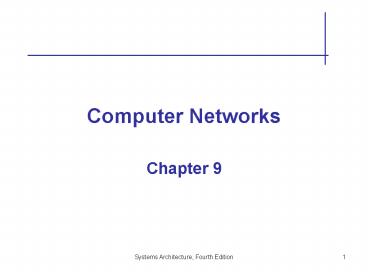Computer Networks PowerPoint PPT Presentation
1 / 42
Title: Computer Networks
1
Computer Networks
- Chapter 9
2
Objectives
- Compare and contrast bus, ring, and star network
topologies - Describe packet routing across local and wide
area networks - Compare and contrast token passing and CSMA/CD
media access control protocols - Describe network hardware devices, including
network interface units, bridges, routers, and
switches - Describe the OSI network model, the TCP/IP
protocol suite, and IEEE network standards
3
Chapter Topics
4
Network Topology
- Network topology
- the spatial organization of network devices
- the physical routing of network cabling
- the flow of messages from one network node to
another
5
Network Topology
- Topology Types
- Point-to-Point transmission the line is laid
over the shortest path and connected directly to
both nodes. Used for small networks. - Shared connections smaller shared links are
connected to larger shared links. Used for larger
networks.
6
Network Topology
7
Network Topology
- Shared Connections
- Store and Forward - interconnected system of end
nodes and transfer points used to route data
among end nodes.
8
Network Topology
9
Network Topology
- Network Topology
- Logical topology refers to the path that
messages traverse as they travel from node to
node. - Physical topology refers to the physical
placement of cables and device connections to
those cables.
10
Network Topology
- Topologies
- Star
- Bus
- Ring
11
Network Topology
- Star Topology
- uses a central node to which all other nodes are
connected - the central node can be a transfer point
- Advantage simple wiring
- Disadvantage the failure of the hub disables the
entire network
12
Network Topology
13
Network Topology
- Bus Topology
- Connects each node to a common transmission line
- Transmitted messages travel from a node across
the common transmission line - Advantages simple wiring and low susceptibility
to failure
14
Network Topology
15
Network Topology
- Ring Topology
- Connects each network node to two
- nodes and the entire network forms a closed
- loop
- Advantages long maximum network length
- and low susceptibility to noise and distortion
16
Network Topology
- Ring Topology
- Disadvantages
- susceptibility to failure
- difficulty adding, deleting and moving nodes
17
Network Topology
18
Network Topology
19
Network Topology
20
Addressing and Routing
- Local Area Network a network covering a floor
or building. - Wide Area Network a network a network that
spans large physical distances, such as multiple
buildings, cities, regions, or continents.
21
Addressing and Routing
- Local Area Network Routing
- Each time a node is started, it sends a message
announcing its presence and its address to the
nearest nodes - Each hub and router maintains a table of node
addresses and transmission lines or connections
ports and uses that table to make routing
decisions
22
Addressing and Routing
23
Addressing and Routing
- Wide Area Network Routing
- Each router knows
- The addresses and physical locations of its own
nodes - Other nearby routers
- Groups of addresses that they control
- Default destination for messages to the addresses
that it does not know
24
Media Access Control
- Methods for dealing with collisions
- Carrier Sense Multiple Access/Collision Detection
(CSMA/CD) - Token Passing
25
Media Access Control
- Carrier Sense Multiple Access/Collision
- Detection (bus topology)
- a node that wants to transmit listens (carrier
sense) until no traffic is detected - the node then transmits its message
26
Media Access Control
- CMSA/CD (cont.)
- the node listens during and immediately after its
transmission. If abnormally high signal levels
are heard, which is a collision detection, then
the node ceases transmission - if a collision is detected, the node waits for a
random time interval and then retransmits its
message
27
Media Access Control
28
Media Access Control
- Token Passing (ring topology)
- a token is passed from node to node
- only the node with the token can pass a message
- Advantage simplicity
- Disadvantage inefficient use of data
- transfer capacity
29
Network Hardware
30
Technology Focus
31
OSI Network Layers
- Open Systems Interconnection (OSI)
- Model
- A conceptual model for network hardware and
software developed by the International Standards
Organization
32
OSI Network Layers
33
OSI Network Layers
- Presentation Layer ensures that data
transmitted by one network node is correctly
interpreted by the other network node - Session Layer establishes and manages
communication sessions - Transport Layer formats messages into packets
suitable for transmission over the network
34
OSI Network Layers
- Network Layer routes packet to their proper
destination - Data Link Layer interface between network
software and hardware - Physical Layer the layer at which communication
between devices actually takes place
35
TCP/IP
- Transmission Control Protocol/Internet
- Protocol (TCP/IP)
- Protocol used by private networks to transmit
data over the Internet. TCP establishes and
manages communication sessions. IP provides
packet routing and forwarding services to higher
network layers.
36
TCP/IP
37
Network Standards
- IEEE 802 telecommunication and network standards
developed by the Institute of Electrical and
Electronic Engineers (IEEE). - Standards describe network hardware, transmission
media, transmission methods and protocols.
38
Network Standards
39
Technology Focus
40
Technology Focus
41
Summary
- Network topology refers to the spatial
organization of network devices, the physical
routing of network cabling and the flow of
messages from one network node to another. - LANs are interconnected to form WANs.
- A media access control (MAC) protocol specifies
rules for accessing a shared transmission medium. - Network hardware devices include NIUs, hubs,
bridges, routers, and switches.
42
Summary
- The Open Systems Interconnection (OSI) model is
an ISO conceptual model that divides network
architecture into seven layers. - TCP/IP is the core Internet protocol suite.
- The IEEE 802 standards cover many types of
networks.

